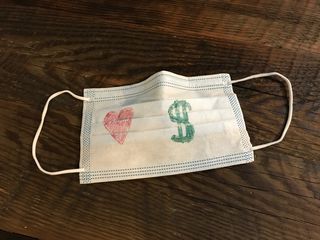Relationships
For Love and Money: The Mask as a Multi-Purpose Tool
Goal pursuit research explains why multitaskers might be overlooked in a crisis.
Posted May 5, 2020

There’s a concept that researchers of goal pursuit talk about called multifinality. It’s the one-word summary we have for the notion of "killing two birds with one stone," or the idea is that any single object or option can help someone achieve two goals. This idea feels (and is) pretty obvious to most people but the psychological implications aren’t as obvious.
One relatively obvious finding we have about items that are multifinal is that they are viewed overall as being more valuable. Your cellphone that connects you to music, the internet, and telephone calls is viewed as more valuable than the landline your parents used to (or still) have that only makes phone calls. So, you’d probably be willing to pay more for a cell phone than a landline. Yes, this feels obvious—the stone that can kill two birds is overall, quite valuable.
But there’s a less obvious finding that I think might be keeping people from embracing masks. This is a thing researchers call the dilution effect. When an object serves multiple purposes, it comes to be seen as less useful for any one of its given purposes. When you have a very strong goal to do something, these multi-purpose items often get overlooked.
Think about when you are trying to cut off a piece of butter from a stick. What item do you think of to use? A knife, right? And probably a butter knife. That object is the most strongly linked to cutting butter. A steak knife would probably do just as well but that item is linked with cutting tasty beef. What about your chef’s knife? Or scissors? Or a fork? In a pinch, I’ve used all sorts of items to cut butter. They’re not the first that come to my mind, but they’ve always worked.
And this is where I think we are hitting a rough spot with masks. When you think of the primary goal attached to a mask, what do you think about? I’m guessing it’s protection—either of yourself or of others. Masks started off as a sign of personal protection. The virus felt like it was everywhere and with no known cure or reliable tracking, masks were viewed as one of the only ways people could protect themselves.
Now, we are recognizing more and more that masks are a way of protecting others. With COVID-19 able to be transmitted without symptoms, it can be hard to know if you can safely go out in public even if you’re not feeling sick. Wearing a mask greatly reduces the risk of sharing the virus with others, even if they aren’t all that effective for personal protection.
As we’ve slowly started to get our feet under us with treating and tracking COVID-19 (though note that in many states, including GA where I write this, the rates of new cases remain just as high this week as they have been for the last several weeks), our eyes are turning to a second crisis related to the pandemic—the economy.
As we think about how to address this crisis, we are most likely to turn to our known uni-taskers. Open stores, open restaurants, get people spending money. We have a known vision for what a working economy looks like and the stronger the crisis is (the stronger our goal to reopen the economy is), the more natural it is for us to turn to that vision to fix the crisis, just like I would first pull out a butter knife to cut off some butter for my toast. The more we want to act, the more we look for the uni-taskers.
Instead, we should look over to the other side of the kitchen for the multi-tasker we already have at hand—the mask.
In addition to protecting others, masks are the key to keeping the economy open. Who can spend money in stores if they are sick or at home worried about others who are sick? Who can work in the stores and businesses we want open if by doing so they risk bringing COVID-19 home to an older relative or an immunocompromised partner? Even if you think the concerns about COVID-19 are inflated, what good does your belief do if your customers are too nervous to shop?
To open the economy, we need everyone to be able to participate. And the mask—often seen as a sign of protection—is the key to that. It’s the way we can support our business owners, workers, health care workers, and each other.
We need to spend less time arguing about which goal is more important right now—health or the economy—and pick up the tools that help with both.
Wear your mask with pride for whatever reason motivates you. And hold the judgment. Remember that everyone else is wearing one for something more complicated than you can see in just their eyes.
References
Orehek, E., Mauro, R., Kruglanski, A. W., & van der Bles, A. M. (2012). Prioritizing association strength versus value: The influence of self-regulatory modes on means evaluation in single goal and multigoal contexts. Journal of Personality and Social Psychology, 102(1), 22–31. https://doi.org/10.1037/a0025881
Köpetz, C., Faber, T., Fishbach, A., & Kruglanski, A. W. (2011). The multifinality constraints effect: How goal multiplicity narrows the means set to a focal end. Journal of Personality and Social Psychology, 100(5), 810–826. https://doi.org/10.1037/a0022980
Zhang, Y., Fishbach, A., & Kruglanski, A. W. (2007). The dilution model: How additional goals undermine the perceived instrumentality of a shared path. Journal of Personality and Social Psychology, 92(3), 389–401. https://doi.org/10.1037/0022-3514.92.3.389
Eikenberry, S. E., Mancuso, M., Iboi, E., Phan, T., Eikenberry, K., Kuang, Y., ... & Gumel, A. B. (2020). To mask or not to mask: Modeling the potential for face mask use by the general public to curtail the COVID-19 pandemic. Infectious Disease Modelling.




